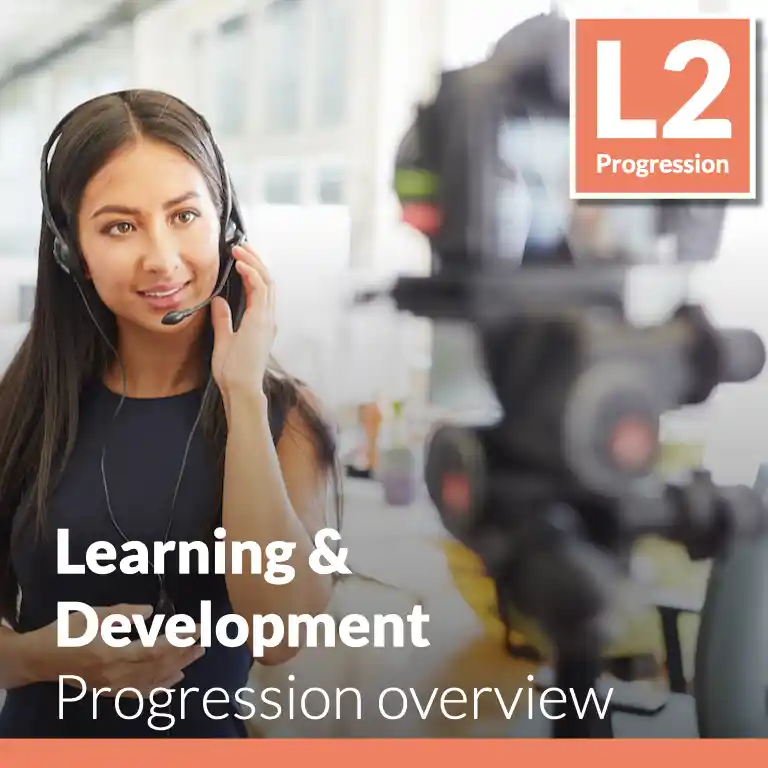Enjoy instant access to a scalable system of proven practices and execution-ready tools. Built to launch strategic HR programs 5X faster!
✓ Enjoy platform access
✓ Create your HR roadmap
✓ View open content in library
✓ Access dozens of practices:
⤷ The HR Strategy program
⤷ Explainers and deep dives
⤷ Supplemental guides
⤷ Insight articles
⤷ Weekly best practices
⤷ And more!
100% Free. No credit card required.
This guide is part of a progression set comprised of Core, Advanced, and Emerging Learning & Development practices.
These practices focus on developing, staffing, and managing a learning and development function that is highly responsive to business needs, employing both technology and non-classroom methods to effectively enhance employee knowledge, skills, and abilities (KSAs). Advanced practices involve senior leadership and management in fostering a corporate culture of continuous learning for every employee, providing resources, support, and encouragement for both company-led and self-directed development opportunities. Top leadership is provided with the guidance and structure necessary to effectively oversee, contribute to, and evaluate the planning, execution, and outcomes of learning and development strategies, programs, and investments.
In a more sophisticated Learning & Development (L&D) function, advanced tools and techniques are utilized to deliver learning whenever and wherever it is needed. These technologies undergo evaluation in a formalized and structured manner, facilitating comparison against the company’s business requirements, capability expectations, cost parameters, and competitive products. Developing these advanced capabilities necessitates a broader set of in-house skills. These skills encompass an understanding of the business requirements that drive learning and programs, acknowledgment of the cultural preferences and expectations that need to be met, and expertise in methods and tools for creating responsive programming. The goal is to minimize reliance on time-consuming and costly classroom training. This approach grants functional supervisors, managers, and employees greater control over what will be learned and when it will be learned. It emphasizes both on-the-job and collaborative learning methods, bringing learning closer to the tasks as they are performed. This enhances relevance to the job, performance requirements, and ultimately, the career progression of each employee.
As the pace of change in business, economic, social, and political environments intensifies, companies must adapt quickly and efficiently. Developing a workforce that responds effectively to change is more crucial than ever for corporate success. Engaging top leadership offers two main benefits: 1) increased attention and awareness of the value that the function provides in maintaining a workforce capable of meeting company objectives, and 2) ensuring that the function is adequately resourced and funded while staying focused on the most critical and urgent business needs (current and future).
A strong internal L&D team regularly engages with business leaders, addresses business imperatives, and promptly prepares the workforce as challenges arise. A business-aligned L&D team, equipped with sufficient skills and technology, is tremendously valuable for any company whose workforce delivers significant value through the provision of products and services. The ability to offer learning and skill development in various forms and through multiple channels enables more cost-effective and targeted skill acquisition, accommodating the diverse learning styles of employees. By tailoring development types to match the preferences and needs of different employee segments, learning can be delivered on the job, at times that best fit each learner, and in ways that align with adult learning principles. With a culture of continuous learning, this workforce can evolve alongside the business, overcoming external challenges through timely and relevant learning and development opportunities.
Adopting these practices acts as a powerful driver of continuous learning by establishing a formal, structured governance model that involves top leaders in designing and executing an enterprise-wide strategy. This approach offers the opportunity to manage programs that remain consistently aligned with business priorities over time. It utilizes highly responsive technologies to provide significantly improved access to various types of learning content in a more democratic and unbiased way for employees across geographic, cultural, functional, and business unit boundaries. It presents a broader and more effective mix of opportunities for skill and knowledge development outside the traditional classroom setting, accommodating all employees' preferences, schedules, and learning styles. It fosters a well-rounded team of L&D professionals who combine diverse capabilities and expertise to design, develop, and deliver quality programs cost-effectively, tailored to meet the unique needs of an organization’s operating style and culture. Additionally, it promotes a culture of continuous learning, where leaders, managers, and employees prioritize, support, and are held accountable for seizing learning opportunities.
Forming and partnering with Learning Councils to help define strategy, approve investment decisions, drive compliance, and oversee execution to ensure alignment with business imperatives.
Creating, managing, delivering, and curating learning content at scale through technology solutions to improve cost-effectiveness and provide a better learner experience with seamless access to find, use, and adopt desired learning content.
Establishing an environment where informal learning opportunities occur in the workflow to enhance or add knowledge, skills, and abilities in a current job or role.
Assembling a Learning & Development function with the right capabilities to understand and act on business and talent needs and support the design and production of quality programming.
Building and maintaining a learning culture that encourages and supports the continuous pursuit of knowledge, sharing of learning, and motivates the upgrade of knowledge, skills, and abilities.

Enjoy instant access to a scalable system of proven practices and execution-ready tools. Built to launch strategic HR programs 5X faster!